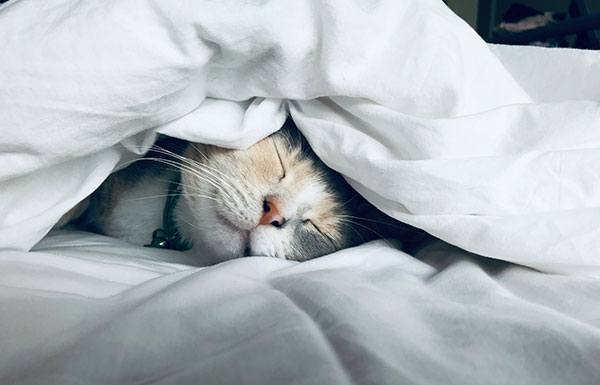
Ever watch your pet sleeping and wonder what’s going on in their mind? Perhaps you’ve noticed gentle paw movements or heard soft sounds while they’re at rest. It’s a quiet, almost sacred moment, and it often brings up a heartfelt question: Do animals dream? That simple thought makes us see our pets in a new light, especially when they appear so peaceful and far away in sleep.
It’s completely natural to feel a little unsure when your pet twitches or makes sounds in their sleep. Many pet parents pause in those moments and ponder over the situation.
So let’s explore what happens during those restful hours. What do they feel? What do they see? And most of all, what might they be dreaming about?
Can Animals Dream Like We Do?

Imagine your pet curled up beside you, eyes closed, body relaxed. What do you think they’re dreaming about?
Science reveals that many animals, including our pets, undergo distinct stages of sleep, much like humans. One of these stages is REM sleep (Rapid Eye Movement), where the brain becomes highly active. This is when dreams usually happen.
During REM, many pets show minor signs like paw twitches, tail flicks, or soft vocal sounds. These little movements might be their way of acting out a dream, reliving their day, chasing something in their minds, or simply exploring a memory.
What Do Animals Dream About?

While we can’t ask them directly, researchers believe pets dream about their real-life experiences. That could mean chasing a toy, hearing your voice, sniffing around the garden, or playing with a favorite companion.
These dreams likely reflect the most familiar and emotionally charged part of their day. That’s why you may notice movement, sound, or changes in their breathing while they sleep.
Try this: Watch your pet next time they doze off. Do you notice any small signs, like ear flicks or paw movements? Those may be clues to their dreaming world.
Do All Animals Dream?
Many pet parents ask: Do all animals dream, or just a few species? Studies show that most mammals and birds experience REM sleep, which makes dreaming very likely. Thus, whether you live with a dog, a cat, a rabbit, or a parrot, chances are they dream, too.
Reptiles and fish have different sleep patterns, and research is still growing. But what we know so far confirms one beautiful thing: many of the animals we care for do have dreams, and those dreams help shape how they think, feel, and respond to their environment.
The Sleep Cycle of Dogs

Dogs have unique rest needs based on their age, breed, and lifestyle. Puppies can snooze up to 18 hours a day, while adults typically get around 12–14. During this downtime, they cycle through different stages of rest.
Interestingly, canines spend about 10% of it in REM—the phase where dreaming happens. That’s when their brains sort memories, learn from the day, and yes, probably chase squirrels in dreamland.
Here’s something to try: Next time your dog naps, count how long it takes before you see movement. That can give you an idea of when REM sleep begins.
The Sleep Cycle of Cats
Cats clock in around 15 hours of sleep a day, sometimes even more if they’re kittens or seniors. That’s a lot of napping. But what’s with all the shut-eye? Are they just lazy, or is there more to the story?
Well, cats are crepuscular. That means they’re most active at dawn and dusk. Their wild ancestors hunted during these times, and that instinct still lingers.
Cats also enter REM sleep, just like dogs and people. And just like us, they probably dream during that stage.
So, can animals dream? Yes. And your cat might be reliving that moment of pouncing on their toy mouse, or even dreaming of you.
Why Do Animals Dream?
Dreaming plays a deeper role than just imagination. Experts believe that animal dreams help with:
- Processing daily experiences
- Supporting memory
- Regulating emotions
Dreaming allows pets to sort through everything they’ve experienced during the day. It helps them learn, adapt, and feel secure. Their brains, like ours, use this time to “replay” important moments, bond-building experiences, and things they might want to remember, like your scent, your voice, or the joy of a walk.
Helping Your Pet Sleep Better
You can support your pet’s dream life by helping them rest well. Here’s how:
1. Make their space comfortable
Choose a quiet, soft place where they feel safe. Familiar scents and cozy bedding help them settle faster.
2. Keep a consistent routine
Regular feeding, play, and sleep times support their body clock and help reduce anxiety.
3. Minimise stress in their environment
Sudden loud noises, changes in routine, or new surroundings can interrupt sleep. Keep things calm, especially in the evening.
Tip: Tonight, when your pet drifts off, sit with them for a moment. Notice how their breathing slows, how peaceful they look. These quiet minutes strengthen the trust they feel in you.
What Animals Dream Reminds Us They Feel Deeply
Your pet’s dreams are a window into their inner world. While we may never know exactly what animals dream, watching them sleep gives us insight into how they process life, love, and the bond they share with us.
Those small twitches, slow tail sways, or soft sleepy sounds? They mean something. They remind us that our pets aren’t just companions, they’re feeling, thinking beings who carry their experiences into their dreams.
Final Thoughts
So, do animals dream? Yes, many do. And their dreams reflect how loved, safe, and emotionally rich their lives can be.

https://shorturl.fm/RHeJC
https://shorturl.fm/Xb3Xu
Nikmati permainan slot gacor terbaik yang hanya ada di situs SLOT GACOR | LOGIN yang memberikan kualitas terbaik dalam proses deposit serta withdraw yang cepat.
https://shorturl.fm/LXiL0